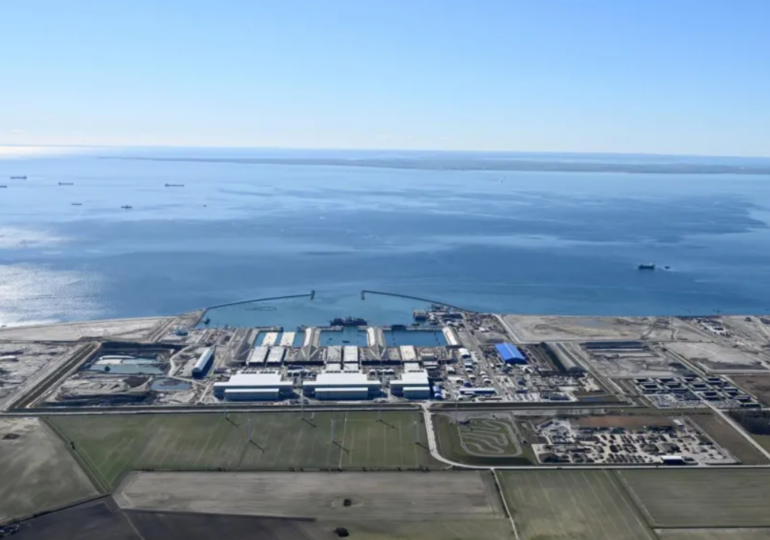A record-sized tunnel is being built under the Baltic Sea, between Denmark and Germany. Once completed, it will significantly reduce travel time and improve the connection of the Scandinavian countries with the rest of Europe.
With a length of 18 kilometers, Fehmarnbelt will be the longest prefabricated road and rail tunnel in the world.
It is also a remarkable engineering achievement, involving placing the tunnel segments on the seabed and then assembling them, writes BBC.
"It's a huge facility"
The main construction site is located at the northern entrance of the tunnel, on the coast of Lolland Island in southeastern Denmark.
The facility spans over 500 hectares and includes a port and a factory where the tunnel sections, called "elements," are produced.
"It's a huge facility here," says Henrik Vincentsen, CEO of Femern, the Danish state company building the tunnel.
Each element, with a length of 217 meters and a width of 42 meters, is made of reinforced steel cast with concrete.
Most subsea tunnels – including the 50-kilometer tunnel between the UK and France – are dug through the seabed bedrock. In contrast, here, 90 individual elements will be assembled piece by piece, like Lego bricks.
"We are setting records with this project. Submerged tunnels have been built before, but never on this scale," Vincentsen states.
Will halve the travel time between Copenhagen and Hamburg
With an estimated cost of around 7.4 billion euros (8.1 billion dollars), the project is largely funded by Denmark, with a contribution of 1.3 billion euros from the European Commission.
It is one of the largest infrastructure projects in the region and is part of a broader EU plan to strengthen transport links between countries, while also reducing reliance on flights.
Once completed, the route between Rødbyhavn in southern Denmark and Puttgarten in northern Germany will take only 10 minutes by car or 7 minutes by train, replacing a 45-minute ferry journey.
By avoiding western Denmark, the new railway route will halve the travel time between Copenhagen and Hamburg – from 5 to 2.5 hours – and will provide a more "green" way for transporting goods and passengers.
"It's not just about the connection between Denmark and Germany, but about linking Scandinavia with Central Europe. Everyone stands to gain. And by traveling 160 kilometers less, the carbon footprint is also reduced," Vincentsen says.
The tunnel is located at the base of a steep coastal cliff. Each element has five parallel tubes. Two are for railway lines, two for roads (with two lanes each way), and one is for maintenance and emergency interventions.
At the other end, giant steel doors keep the sea at bay. "As you hear, they are quite thick," says Anders Gert Wede, senior construction manager, hitting the metal. "When we have a completed element in the port, it is towed to the location and then carefully submerged behind these doors."
The next step is an extremely complex process, involving lowering the elements to a depth of 40 meters in a trench excavated on the seabed, using underwater cameras and GPS-guided equipment with a precision of 15 millimeters.
The bridge was not a feasible option
Denmark is located at the mouth of the Baltic Sea, an area with intense maritime traffic.
The subsoil is too soft for drilling a bored tunnel, says Professor Per Goltermann from the Technical University of Denmark.
Initially, a bridge option was considered, but strong winds could disrupt traffic, and safety was another important factor.
"There is a risk of ships hitting the bridge. A bridge that can withstand can be built, but the waters are quite deep, and large vessels navigate there," he adds.
Therefore, the decision was made to build a submerged tunnel. "They looked at options and said, 'What's the cheapest? The tunnel. What's the safest? The tunnel,'" he says.
Denmark and Germany signed an agreement to build the tunnel back in 2008, but the project was delayed by opposition from ferry companies and environmental groups in Germany, concerned about the ecological impact.
When the tunnel opens in 2029, estimates show that it will be used daily by over 100 trains and 12,000 cars.
According to plans, the revenues collected from tolls will cover the state-guaranteed loans taken for financing, which will take about four decades.
It is also hoped that this massive investment will boost jobs, businesses, and tourism in Lolland, one of the poorest regions in Denmark.
"The locals here have been waiting for this project for years. They are eagerly anticipating businesses coming to the area," Wede says.

